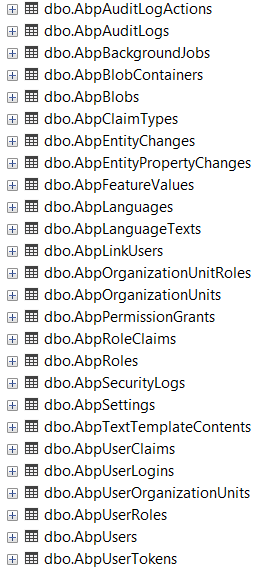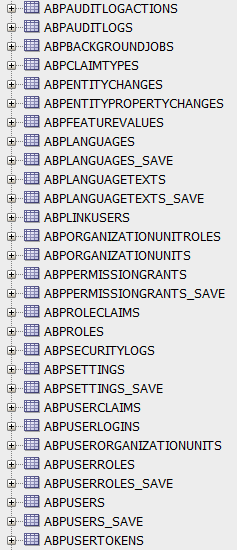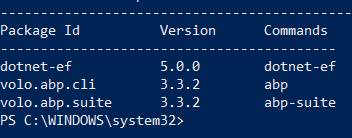Activities of "alexander.nikonov"
Thank you. I have added those configuring methods. I already had corresponding modules included into DependsOn on all layers.
So I run DbMigrator expecting it would create missing tables now. However, this did not happen - the tables are still missing. What do I do?
Please find below:
using Microsoft.EntityFrameworkCore;
using Microsoft.Extensions.Configuration;
using System.IO;
using Volo.Abp.AuditLogging.EntityFrameworkCore;
using Volo.Abp.BackgroundJobs.EntityFrameworkCore;
using Volo.Abp.EntityFrameworkCore;
using Volo.Abp.FeatureManagement.EntityFrameworkCore;
using Volo.Abp.Identity.EntityFrameworkCore;
using Volo.Abp.IdentityServer.EntityFrameworkCore;
using Volo.Abp.LanguageManagement.EntityFrameworkCore;
using Volo.Abp.PermissionManagement.EntityFrameworkCore;
using Volo.Abp.SettingManagement.EntityFrameworkCore;
using Volo.Saas.EntityFrameworkCore;
namespace AbxEps.CentralTools.EntityFrameworkCore
{
/* This DbContext is only used for database migrations.
* It is not used on runtime. See CentralToolsDbContext for the runtime DbContext.
* It is a unified model that includes configuration for
* all used modules and your application.
*/
public class CentralToolsMigrationsDbContext : AbpDbContext<CentralToolsMigrationsDbContext>
{
public CentralToolsMigrationsDbContext(DbContextOptions<CentralToolsMigrationsDbContext> options)
: base(options)
{
}
protected override void OnConfiguring(DbContextOptionsBuilder optionsBuilder)
{
var configuration = BuildConfiguration();
optionsBuilder.UseOracle(
configuration.GetConnectionString("Default"),
default(System.Action<Devart.Data.Oracle.Entity.OracleDbContextOptionsBuilder>));
}
protected override void OnModelCreating(ModelBuilder builder)
{
var config = Devart.Data.Oracle.Entity.Configuration.OracleEntityProviderConfig.Instance;
config.Workarounds.DisableQuoting = true;
config.CodeFirstOptions.UseNonLobStrings = true;
config.CodeFirstOptions.UseNonUnicodeStrings = true;
base.OnModelCreating(builder);
/* Include modules to your migration db context */
builder.ConfigurePermissionManagement();
builder.ConfigureSettingManagement();
builder.ConfigureBackgroundJobs();
builder.ConfigureAuditLogging();
builder.ConfigureIdentityPro();
builder.ConfigureIdentityServer();
builder.ConfigureFeatureManagement();
builder.ConfigureLanguageManagement();
builder.ConfigureSaas();
/* Configure your own tables/entities inside the ConfigureCentralTools method */
//builder.ConfigureCentralTools();
}
private static IConfigurationRoot BuildConfiguration()
{
var builder = new ConfigurationBuilder()
.SetBasePath(Directory.GetCurrentDirectory())
.AddJsonFile("appsettings.json", optional: false);
return builder.Build();
}
}
}
using Microsoft.EntityFrameworkCore;
using Microsoft.Extensions.DependencyInjection;
using Microsoft.Extensions.Logging;
using Volo.Abp.AuditLogging.EntityFrameworkCore;
using Volo.Abp.BackgroundJobs.EntityFrameworkCore;
using Volo.Abp.BlobStoring.Database.EntityFrameworkCore;
using Volo.Abp.EntityFrameworkCore;
using Volo.Abp.FeatureManagement.EntityFrameworkCore;
using Volo.Abp.Identity.EntityFrameworkCore;
using Volo.Abp.IdentityServer.EntityFrameworkCore;
using Volo.Abp.LanguageManagement.EntityFrameworkCore;
using Volo.Abp.Modularity;
using Volo.Abp.PermissionManagement.EntityFrameworkCore;
using Volo.Abp.SettingManagement.EntityFrameworkCore;
using Volo.Abp.TextTemplateManagement.EntityFrameworkCore;
using Volo.Saas.EntityFrameworkCore;
using AbxEps.CT.Batch.EntityFrameworkCore;
using AbxEps.Abp.EF.Oracle.Extensions.Interceptors;
using AbxEps.CT.Core.EntityFrameworkCore;
using Volo.Abp.Auditing;
using AbxEps.CentralTools.Images.Handlers;
namespace AbxEps.CentralTools.EntityFrameworkCore
{
[DependsOn(
typeof(CentralToolsDomainModule),
typeof(AbpIdentityProEntityFrameworkCoreModule),
typeof(AbpIdentityServerEntityFrameworkCoreModule),
typeof(AbpPermissionManagementEntityFrameworkCoreModule),
typeof(AbpSettingManagementEntityFrameworkCoreModule),
typeof(AbpBackgroundJobsEntityFrameworkCoreModule),
typeof(AbpAuditLoggingEntityFrameworkCoreModule),
typeof(AbpFeatureManagementEntityFrameworkCoreModule),
typeof(LanguageManagementEntityFrameworkCoreModule),
typeof(SaasEntityFrameworkCoreModule),
typeof(TextTemplateManagementEntityFrameworkCoreModule),
typeof(BlobStoringDatabaseEntityFrameworkCoreModule),
typeof(CoreEntityFrameworkCoreModule),
typeof(BatchEntityFrameworkCoreModule)
)]
public class CentralToolsEntityFrameworkCoreModule : AbpModule
{
public override void PreConfigureServices(ServiceConfigurationContext context)
{
CentralToolsEfCoreEntityExtensionMappings.Configure();
}
public override void ConfigureServices(ServiceConfigurationContext context)
{
context.Services.AddAbpDbContext<CentralToolsDbContext>(options =>
{
/* Remove "includeAllEntities: true" to create
* default repositories only for aggregate roots */
options.AddDefaultRepositories(includeAllEntities: true);
});
context.Services.AddTransient<IAuditPropertySetter, Abp.DataExtensions.Entities.LogAuditPropertySetter>();
context.Services.AddTransient<IImageHandler, ImageHandler>();
Configure<AbpDbContextOptions>(options =>
{
options.PreConfigure(abpDbContextConfigurationContext =>
{
abpDbContextConfigurationContext.DbContextOptions.UseLoggerFactory(
LoggerFactory.Create(loggingBuilder => loggingBuilder.AddConsole()));
abpDbContextConfigurationContext.DbContextOptions.AddInterceptors(new RemoveQuotesInterceptor());
abpDbContextConfigurationContext.DbContextOptions.EnableSensitiveDataLogging();
});
options.UseOracle();
});
}
}
}
I already did such a compare, but it did not help me. Because a new project does not have previous migration classes - from version 3.3.2, as in my case. So I cannot figure out what went wrong when I was doing update-database. To provide you the details, I've attached two migration classes (see in my first message): previous one, version 3.3.2 and current one, version 4.3.0.
Obviously, some tables have not been created which are now required for ABP 4.3.0 to function properly.
From your documentation I cannot understand how to have those missing tables created and how to make "Forgot password" functionality function properly now (when it needs AbpTextTemplateContents table which has not been created during migration).
@maliming
Thank you.
But as I've already mentioned in GitHub item, I have already made migration. And I did read the manual - I run update-database and I did data seeding for IdentityServer. I re-read those migration guides, however I cannot find anything related to my issue.
So please help me to resolve it.
there are missing tables because you might not have these modules: AbpBlobContainers, AbpTextTemplateContents If you create a new project these modules come by default that's why you see the difference in migration. You need to add these modules manually (if you require them)
@alper I did not expect to need this(these) module(s), but I got exception when trying to use "Forgot password" functionality - there was exception related to missing table - AbpTextTemplateContents. But even if this table is to be created when I add the corresponding module - it's gonna be empty? IMHO It should not require some email templates as "mustbe"? Or should be some default templates created automatically as I see it.
Anyway, I am not sure it's quite obvious I need this table, because in the previous versions of ABP I didn't have this table and "Forgot password" worked as expected (i.e. email was sent)... So the question is: how to make "Forgot password" functionality work now? BTW, I need to fine-tune password update, because we use multi-tenant custom logic and I will need to update the password for all logins (usernames) with the same name at other tenants...
I've upgraded our solution from ABP 3.3.2 to 4.3.0.
Everything was more or less smoothly, but now I discovered a problem: some new ABP tables are missing from migration scripts! How come? What am I supposed to do now?
Please have a look at the migration classes autogenerated for 3.3.2 and 4.3.0. https://1drv.ms/u/s!AhWdpZddvifTtizt4xjre044i7B8?e=0xuBUs
Here is the list of ABP-prefixed tables created from test solution (autogenerated in ABP Suite) using DbMigrator project in local MS SQL server DB - all the tables are at place:

Here is the list of tables in our ORACLE DB created using standard update-database command and DbMigrator afterwards to seed data - make a note some tables are missing (for instance, AbpBlobContainers, AbpTextTemplateContents). How it's possible?? How to easily find out what is missing and add it?

The missing table has been identified while trying to use "Forgot password" functionality: it appeared this functionality now needs to access AbpTextTemplateContents table.
So please advice how to make Forgot password work having AbpTextTemplateContents at place. Also make a note: I need to intercept change password functionality (override Identity Account Service?) - I need to change password for all users with the same loginname at other tenants!
And if I get it right - ABP documentation needs to be updated here. Now:
How to Install Text Template Management module is pre-installed in the startup templates. So, no need to manually install it.
To be changed to:
How to Install If you are using ABP version 4.x.x (where this module appeared?) Text Template Management module is pre-installed in the startup templates. So, no need to manually install it. If you are using ABP version 3.x.x - you have to ....
I've upgraded our solution from ABP 3.3.2 to 4.3.0.
Everything was more or less smoothly, but now I discovered a problem: some new ABP tables are missing from migration scripts! How come? What am I supposed to do now?
Please have a look at the migration classes autogenerated for 3.3.2 and 4.3.0. https://1drv.ms/u/s!AhWdpZddvifTtizt4xjre044i7B8?e=0xuBUs
Here is the list of ABP-prefixed tables created from test solution (autogenerated in ABP Suite) using DbMigrator project in local MS SQL server DB - all the tables are at place:

Here is the list of tables in our ORACLE DB created using standard update-database command and DbMigrator afterwards to seed data - make a note some tables are missing (for instance, AbpBlobContainers, AbpTextTemplateContents). How it's possible?? How to easily find out what is missing and add it?

Hi.
We found out that the class which implements IPermissionStore interface has different behavior than we expected. This class has limitation on checking granted permission. It can check any permission which was declared in current ABP module for some roles, but due to the limitation, it doesn't allow to check granted permission which was declared in other module for the same roles.
Also please pay attention to property CurrentUser. As you can see, this property returns object with information about the user who sent request. And the field UserName is null. Could you please explain how it can be fixed or what we did wrong? This field is required for us.
By chance I realized when my error takes place! It happens when there is no any ABP solution created! But it needs to be able to download ABP modules source code even if no solution created so far, right?
